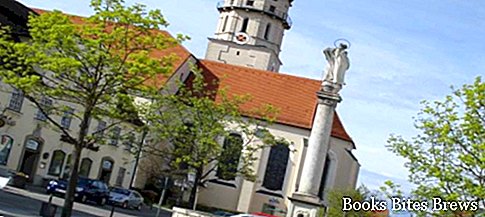What to see in Schongau, what are the main places and attractions to visit in the ancient medieval village of Bavaria, located along the route of the Romantic Road in Germany.
Tourist information
The current settlement was built in the thirteenth century on a mountain surrounded by Lech, while the original city is located on the border of Altenstadt.
Since 1331 Schongau had obtained civic rights associated with significant privileges.
It experienced a remarkable development as a center for trade, until, with the discovery of America and the sea routes for Southeast Asia, the trade routes changed direction.
The romantic medieval town has 12,000 inhabitants, mostly residing outside the city walls.
If you arrive by car, it is advisable to park at the free garage located in the Amtsgerichtsgasse, from here, following the Weinstrasse, it takes a few minutes to reach the current town hall, built in 1922.
In front of the town hall stands the parish church of Santa Maria Assunta, whose bell tower and choir were built in the 17th century and the central nave in 1751.
The subjects of many frescoes and the statues of the church concern the life of Mary, whose statue is also located in the center of the richly decorated main altar. The painting of the choir ceiling shows the Assumption of Mary to Heaven by means of the Holy Trinity.
The Holy Spirit is depicted in the guise of a baroque knight.
To the south of the church extends Marienplatz, closed to the south by the stepped pediment of the Ballenhaus.
The Gothic-style building served first as a warehouse and then, until 1902, as a town hall. The Ratsstube tavern dates back to the same period, richly furnished.
Recommended readings- Dresden (Germany): what to see
- Octoberfest (Germany): beer festival in Munich
- Stuttgart (Germany): what to see
- Hamburg (Germany): what to see in the main port
- Hohenfurch (Germany): what to see
Successor of the town hall was the nearby Alte Rathaus, or old town hall, which has now become a municipal conservatory. The building has rich grouting by Franz Schumuzer.
Looking again towards Marienplatz, on the right, at the height of the fountain, there is the finance department, which previously housed the barn of the convent of Rottenbuch and after the Bavarian royal accounting.
What see
In the center of the square, the column of the Marienbrunnen fountain, 8.5 meters high and decorated with coats of arms, draws attention.
It is a work by the sculptor Bernd Schmitt from 1949.
Here the Lowenstrasse flows from the west, along which you reach the former town pharmacy, until about 1800 brewery, of which the romantic inner courtyard is to be seen above all.
At the end of the Lowenstrasse, turning left and, one block ahead, on the right, you will find the Frauentor gate, whose paintings from the 1700s with the Madonna are the work of the mayor Johann Pollandt.
After passing the gate, following the walls to the left, you reach the Polizeidienerturm tower, which with its 17.25 meters constitutes the highest bulwark of the town, in the past with an additional function to the defensive one, a supervised entrance for guests or citizens arriving after closing time.
From the end of the tower you can admire a wonderful panorama including the Lech and the mountains.
The next tower, Eckturm, 15 meters high, is slightly smaller than the previous one.
Through the wide Lechtorstrasse, you return to the historic center, you should immediately turn right following the Karmelitenstrasse to the end.
Along the way we meet the house of Judge Steingaden of 1492, opposite the left the Church of Santo Spirito, built for the Carmelite convent founded in 1719.
The modest decor of the church, typical of the order of its friars and aimed at simplicity, disappears with the presence of the wonderful seven altars, the precious organ and the beautiful pulpit.
Leaving the church of Santo Spirito, continue straight along the Amtsgerichtsstrasse to the cemetery, where it is mandatory to turn left, meeting the Church of San Sebastiano, consecrated in 1774.
Here the altar of the choir and the upper painting of the right side altar, depicting Saint Magno with the dragon, protector of all the parasites of the gardens and fields, deserve to be especially observed.
On the wide Munzstrasse, to the right, you can see the mint building, later used first as a prison and then as a police station.
After passing the Konigstor gate of 1331, following the path outside the walls to the left, you will find the Sanctuary of Santa Croce, a building built in place of a previous wooden chapel, the work of Joseph Schmuzer in 1690 and subsequently enlarged in 1725.
By continuing to walk you will reach the Maxtor gate, formerly the door of the Schongau castle courtyard.
A fresco on the door recalls the granting of civic rights by the Bavarian emperor Ludwig the 1331. Above it stands the castle, in the fifteenth century the minor residence of the Wittelsbacher and later the seat of the judge with the toga.
Along the Christophstrasse you return to the town hall, first meeting the city museum, set up in the former Church of Sant'Erasmo, where there is a remarkable collection of coins found inside a terracotta container buried during the siege of 1372.




